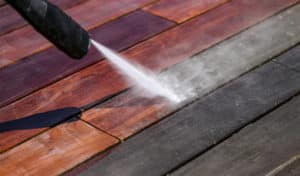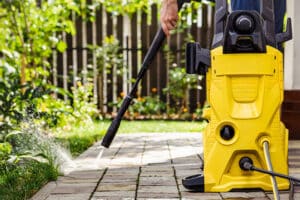9 Pressure Washing Mistakes When You Do It Yourself

Pressure washing is an effective way to clean residential and commercial properties. Wanting to save a buck, though, you might end up attempting to take a DIY approach. But, that only opens you to many pressure washing mistakes.
The Most Crucial Pressure Washing Mistakes to Avoid
Pressure washing is a method of cleaning that uses high-pressure water to blast away dirt, dust, and debris. It is a cleaning method favored by many, including residential and commercial property owners. Pressure washing isn’t very straightforward, though. While it might look simple enough to do on your own, there are several errors you can make along the way.
Here are the top mistakes when pressure washing on your own.
1. No Protection
When professionals provide tips for power washing, the first tip usually revolves around protection. Pressure washing uses high-pressure water, which can easily and seriously wound you. It can even slice flesh depending on the pressure level you set it to. When water or dirt gets into the wound, you risk an infection.
Thus, it is important to wear protective gear as well as goggles when handling a pressure washer. Don’t forget to wear a pair of boots, too. Wear open-toe shoes and you might have to say goodbye to a toe or two.
In addition to protecting yourself, you should also protect your surroundings. Make sure to move furniture and other debris away from the cleaning area. If there is vegetation nearby, either wet them down or cover them with a tarpaulin. The pressure washing process uses detergents and cleansers, which can damage foliage.
2. Too Much Pressure

There is a correct pressure level for every kind of material. Wood and aluminum, for instance, tend to require a lower pressure setting. Concrete and asphalt, on the other hand, can withstand a higher level. If you want to pressure wash glass, you have to be extremely careful as it can break very easily.
When pressure washing on your own, make sure to start on the lowest setting and only wash a single, small area. From there, you can slowly increase the pressure level. This way, you can avoid property damage from power washing.
3. Incorrect Nozzle
People often ask for pressure washing tips and tricks as they keep damaging the materials they try to clean. One of the most important tips is to use the right nozzle for the job. Most pressure washers allow you to adjust the tip of the hose. These are called nozzles — and they come in different sizes. Some are small, allowing you to blast areas with a narrow stream of water. Others are wide, allowing you to apply the water in a fan-like stream. Of course, the more narrow the nozzle, the more focused and forceful the pressure.
Generally speaking, smaller tips are best for getting rid of stubborn filth, while larger tips are good for clean-ups. But, if you want to take the DIY route, it is best to use a wider nozzle first. A wider nozzle decreases your chance of damaging the surface. When you decide to upgrade to a more narrow tip, spray a small section of the area as a test run before washing the entire space.
4. Wrong Angles
When it comes to pressure washing, angles play a critical role, particularly if you’re washing siding. Sidings naturally have openings at the bottom. As such, if you spray the water upward into the siding, the water will enter the inside of the property. This will result in flooding, mold growth, and property damage.
Because houses and buildings tend to stand tall, your initial instinct is to hold the wand at an upward angle to reach high places. And while this isn’t necessarily wrong, you have to use an extension wand that ends with a downward angle.
5. Incorrect Sequence
Pressure washing is almost an art form in that there is a rhythm and sequence to it. You might have an inclination to start pressure washing from the bottom. But, doing it from the ground up will only cancel out your hard work.
When pressure washing a house or building, you should always start with the roof and work your way down. If you do the roof last, the dirt that flows down with the runoff will muddy up the siding and walls you already cleaned. Then, you will have to do everything all over again.
Speaking of roofs, tread cautiously when pressure washing them. Not all roof materials can take the force of a pressure washer. And, if you do decide to wash the roof, use an extension wand instead of climbing up on a ladder. The latter might cause you to fall and injure yourself.
6. Lack of Detergents or Cleaning Solutions

As with nozzles, there are different kinds of cleansers you can use. Not all detergents are compatible with all materials. For instance, oil or grease stains typically won’t come out with just your run-of-the-mill detergent; for that, you will need a degreaser.
When applying detergent, make sure to follow the product’s instructions. You might have to let the product sit for a few minutes so it can do its work. After that, you can wash it off. There are also plenty of detergents that are safe to come into contact with plants.
7. Gas-Powered Washers Indoors
Pressure washing is usually a cleaning method used for exterior surfaces like sidings and roofs. But, every now and then, someone will want to clean the inside of their home as well.
While it is possible to use a pressure washer indoors, it is best to use washers that run on electricity instead of gas. Sure, it may be a hassle to use electric washers because of the cord. But, gas-powered pressure washers can give off carbon monoxide. And, without proper ventilation, these pressure washers can poison the occupants of the house or building.
8. Pressure Washing Surfaces Prone to Mold
Pressure washing with cleaning solutions is an effective way to remove mildew and mold. However, not every surface should be cleaned this way. This is because some surfaces, like fabric and drywall, cannot dry as thoroughly or quickly as other materials. As a result, they may develop mold before they even dry out. Make sure to pressure wash only the surfaces that can dry completely.
9. Using Heated Water
Power washing, a technique in pressure washing that uses hot water or steam, can be an effective cleaning method for industrial and commercial structures. However, residential exteriors are usually not as sturdy as commercial ones. You may accidentally damage or warp your home and furniture if you use hot water.
A Surefire Way to Avoid Mistakes
Obviously, there are a handful of pressure washing mistakes you can commit when you take a DIY approach. Understanding what these mistakes are will allow you to avoid them. However, the best possible way to ensure you don’t make these errors is to hire a professional pressure washing company instead.
Superb Softwash provides expert residential and commercial pressure washing services. With years of experience, you can bet on us. Call us today at 210.649.5655 or contact us online to get a free estimate!
RELATED ARTICLES:
